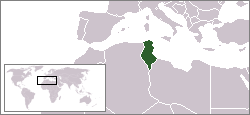Viticulture in Tunisia
The Tunisian wine has a long tradition, as with many other Mediterranean countries also by the Phoenicians , here in particular by the Carthaginians was founded.
The further history of viticulture in Tunisia also coincides with many other North African countries. It flourished under Roman rule, despite Muslim rule from the 7th century AD, viticulture and wine production remained, but lost its importance.
Under French rule from 1881 onwards , there was a renewed upswing in wine production. At that time there was only about 1,000 hectares of vineyards in Tunisia and 95% were intended for growing table grapes; the remaining 50 hectares, which were intended for viticulture, were already firmly in French hands. Tunisia became a supplier of cover and blending wines. This went well for a while after Tunisia was already independent from France. It was not until the mid- 1960s , when French property was expropriated and the planned economy introduced, that wine production plunged into a deep crisis.
Today Tunisia has a wine law based on the French model with AOC appellations. This is an asset today as the wines on the shelves look like they come from France. As in Algeria , viticulture is almost entirely controlled by the state. Most of the varieties are still grown that are also found in southern France . These include Cabernet , Cinsault , Alicante Bouschet , Grenache , Syrah , Mourvèdre , Clairette Blanche and Muscat de Frontignan . The desert storms often cause problems. Now and then the harvest is literally blown by the wind . In years with a good harvest, around 400,000 hectoliters of wine are produced on an area of around 29,000 hectares . The acreage for wine production is declining sharply, and table grape production is gaining in importance. The wines are mainly full-bodied red and rosé wines .
Quality wines in Tunisia
The Appellation d'Origine Contrôlée (AOC for short) wines from Tunisia are:
- AOC Grand Cru Mornag
The area is about 40 km south of Tunis . The red wines are strong with well-built-in tannins and go well with meat and game dishes. The main variety, Carignan, which grows in bush form, is usually blended with stronger varieties such as Syrah or Cabernet Sauvignon. Internationally recognized rosé wines come mostly from Cinsault and Grenache, the white wines such as Ugni Blanc and Rezzegui are light and pleasant to drink.
Well-known wineries: Domaine Atlas, Domaine de Charmettes, Château Mornag
- AOC Mornag
The AOC is the largest AOC in Tunisia. It extends from Grombalia , Takelsa to Korba in the east and Enfidha in the south. Red, rosé and white wines are grown. The climate is dry. The annual rainfall amounts to 300 to 480 mm / year. Due to the proximity to the sea, the humidity is higher than normal and the temperature fluctuations are not too extreme. The use of high quality grape varieties made it possible to achieve good improvements in the wines.
Well-known wineries: Domaine Atlas, Domaine d'Ouzra, Domaine Kurubis
- AOC Thibar
The region has a climate with cold winters, hot summers and an annual rainfall of 500 mm / year. White, rosé and red wines are produced here.
Well-known wineries: Domaine de Thibar
- AOC Coteaux d'Utique
The region is about 40 km north of Tunis.
Well-known wineries: Château Fériani, Domaine Karim, Côteaux d'Utique, Côteaux de Mateur, Côteaux de Bizerte
- AOC Tebourba
Large growing region with good name wines. Red and rosé wines are produced.
Well-known wineries: Côteaux de Tébourba, Côteaux de Schuiggui, Domaine de Lansarine, Tébourba Village
- AOC Sidi Salem
30 km south of Tunis. The amount of precipitation is 500 to 600 mm per year. Red and rosé wines are produced.
Well-known wineries: Domaine Nepheris, Côteaux de Khanguet, Khanguet Village, Château Khanguet, Château Saint-Augustin
- AOC Kelibia
This area is about 140 km from Tunis near Cap Bon . There is a Mediterranean climate. Only one grape variety is grown, the muscatel variety Alexandria, also called "muscat de kélibia". The wines are dry and fruity.
